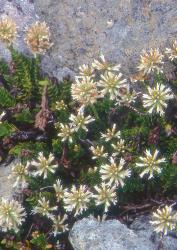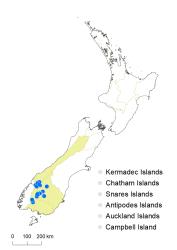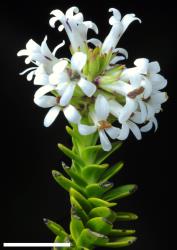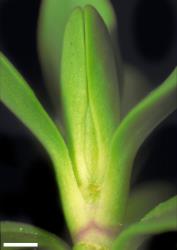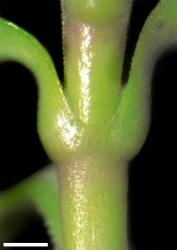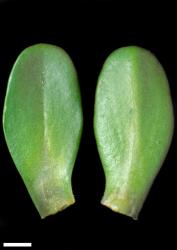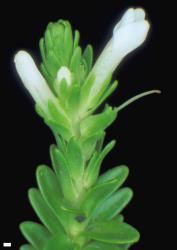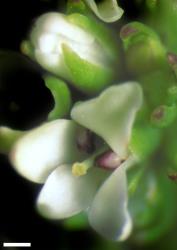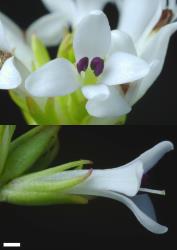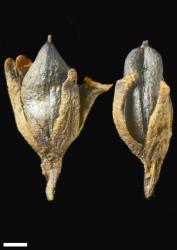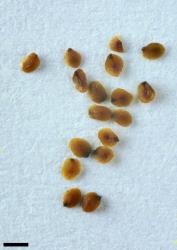- ≡ Mitrasacme petriei Buchanan, Trans. & Proc. New Zealand Inst. 14: 349 (1882)
- ≡ Hebe petriei (Buchanan) Cockayne & Allan, Trans. New Zealand Inst. 57: 42 (1926)
- ≡ Leonohebe petriei (Buchanan) Heads, Bot. Soc. Otago Newsl. 5: 6 (1987)
Sub-shrub or spreading low shrub to 0.3 m tall. Stems decumbent, glabrous or eglandular-puberulent; hairs bifarious. Leaf bud distinct, its outer leaves fully grown, diverging but leaving a narrow, acute sinus at the base. Leaves opposite-decussate to sub-distichous, shortly connate in pairs and encircling stem, erecto-patent to recurved; lamina sub-coriaceous, obovate, oblong, elliptic, or narrow elliptic, 4–12 mm long, 2.0–5.5 mm wide, dull or slightly glossy green above and beneath; midrib weak; surfaces glabrous or eglandular-hairy near base above; margin glabrous or minutely ciliolate especially towards base, entire, sometimes reddish; apex obtuse to rounded; base cuneate; petiole indistinct, 0.5–3.0 mm long. Inflorescence a terminal raceme, 8–60 mm long; flowers crowded, 18–62 per inflorescence, female or bisexual on separate plants, ⚥ > ♀; bracts alternate, the lower sterile, linear to lanceolate, > pedicels; pedicels erect to erecto-patent, 0.5–2.5 mm long, mixed eglandular- and glandular-puberulent all around. Calyx lobes 4–5, acute to acuminate, 3.5–6.0 mm long, sub-equal to unequal, ciliolate with glandular or eglandular or mixed hairs. Corolla 5–8 mm diameter; tube white, 2.5–7.0 mm long, ≥ calyx, glabrous; lobes 4, white, sub-erect to recurved, sub-equal or unequal, linear to narrowly elliptic, posterior sometimes sub-orbicular, 2.5–4.0 mm long, sub-acute to obtuse, posterior sometimes emarginate; nectar guides absent. Stamen filaments white, 1.3–1.7 mm long; anthers magenta. Style glabrous, 3–6 mm long. Capsules latiseptate, acute or acuminate, glabrous, 4.0–4.5 mm long, 1.7–2.5 mm at widest point. Seeds ellipsoid to discoid, flattened, smooth, pale brown or brown, 0.7–1.1 mm long.
murrellii | petriei | |
Stem | glabrous or broadly bifariously puberulent | glabrous or puberulent at connate leaf bases |
Leaf bases | barely connate for 0.2–0.5 mm | connate for c. 0.5 mm |
Floral bracts | 3.5–5 × 1.7–2 mm, ovate to elliptic, usually all subtending flowers | 5–7 × 1–1.5 mm, linear to lanceolate, usually numerous sterile ones at base of inflorescence |
Calyx lobes | 4; 2.5–4 mm long, linear, lanceolate or narrowly elliptic, subacute to obtuse | 4–5, 3.5–6 mm long, linear to narrowly ovate, acute to acuminate |
Corolla tube | 1.5–2 mm long, funnelform | 3–6 mm long, cylindric |
Corolla lobes | elliptic to orbicular | linear to narrowly elliptic, posterior sometimes suborbicular |
Anthers | exserted, purple | presented at corolla throat, magenta |
South Island: Westland (east of the Main Divide in the far south only), Otago, Southland, from catchments at the head of Lake Wakatipu to the Pisa, Livingston, Eyre, Garvie, and Takitimu Mountains.
Alpine rocks and scree. Recorded elevations range from 1040 to 1846 m.
Flowers: October–March (mostly December–February); fruits: November–March.
2n = 42 (see Bayly & Kellow 2006, as Hebe petriei).
Veronica petriei is classified in V. subg. Pseudoveronica sect. Hebe and the informal group “Connatae” (Albach & Meudt 2010; Bayly & Kellow 2006). However, ITS sequence data indicate that V. petriei is an early lineage that diverges near the base of the shrubby hebe clade (Wagstaff et al. 2002; Meudt et al. 2015). It and V. murrellii appear not to be closely related to other “Connatae”.
The inflorescence indumentum is variable, especially on the bracts, which can be densely glandular-puberulent at the base or glabrous.



